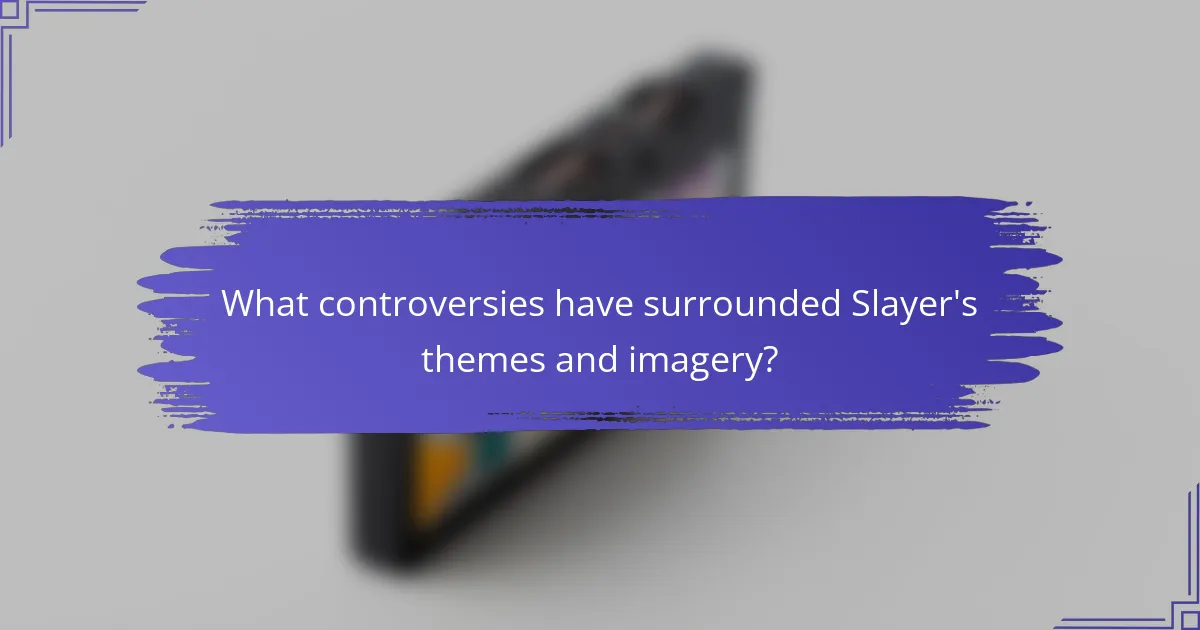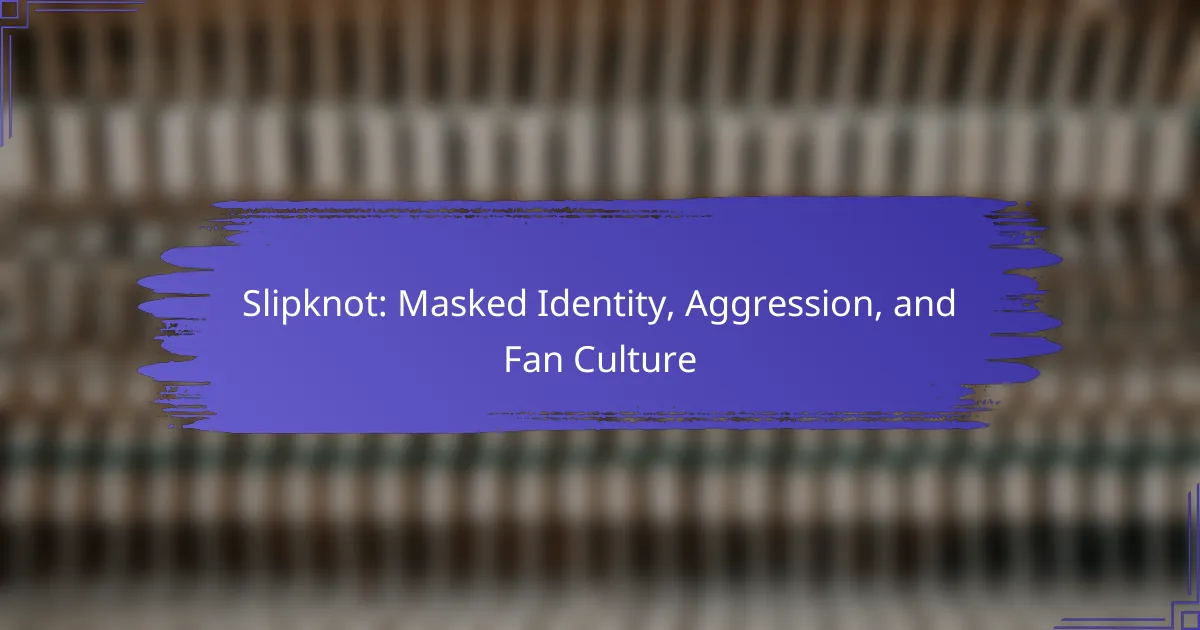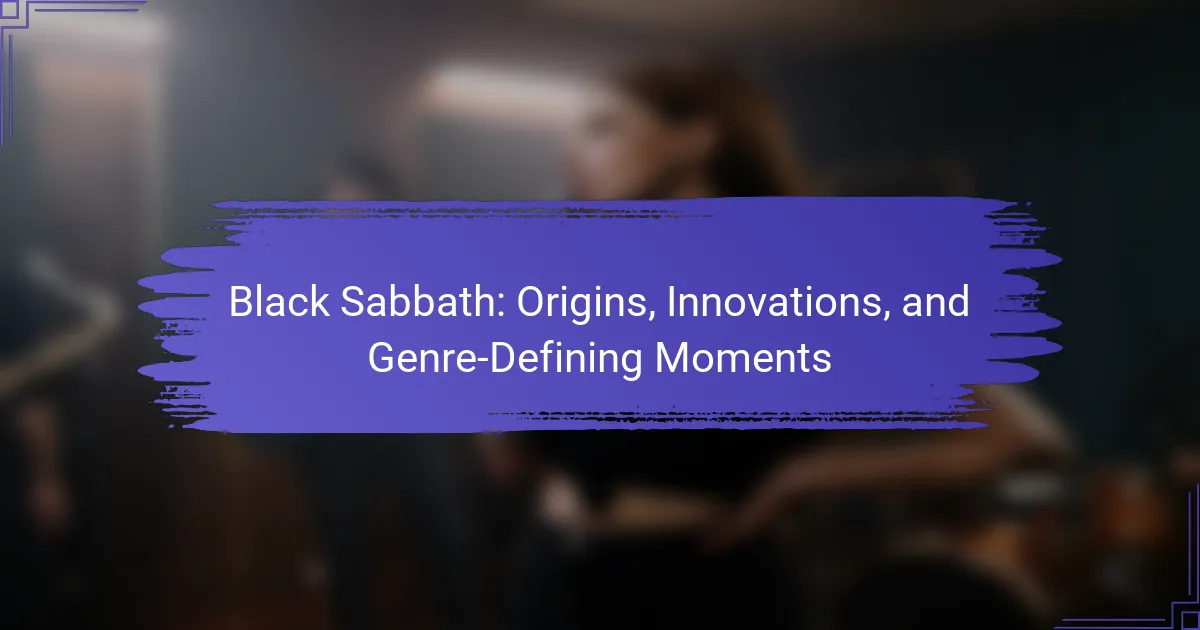Slayer is a seminal thrash metal band known for their aggressive sound and controversial themes. The article explores their defining musical characteristics, significant influence on the genre, and the controversies surrounding their lyrical content. It also examines the band’s diverse fanbase and the intensity of their live performances. Understanding these aspects reveals Slayer’s impact on music and society.

What are Slayer’s defining musical characteristics?
Slayer’s defining musical characteristics include aggressive guitar riffs, fast tempos, and intricate solos. Their sound is marked by harsh vocals and themes of violence and societal issues. The band’s unique attribute is their blend of speed and technicality, setting them apart in thrash metal. Rarely, they incorporate elements from other genres, enhancing their distinctive style.
How do Slayer’s guitar riffs shape their sound?
Slayer’s guitar riffs are integral to their sound, characterized by speed, aggression, and complexity. The band’s use of palm-muted chugging and rapid alternate picking creates a distinct thrash metal style. Their unique attribute lies in the combination of intricate solos and rhythmic intensity, which sets them apart from other bands. This approach not only shapes their musical identity but also influences the thrash metal genre as a whole.
What role does drumming play in Slayer’s music?
Drumming is a crucial element in Slayer’s music, driving their aggressive thrash metal sound. The band’s drummer, Dave Lombardo, is known for his fast, intricate rhythms and double bass patterns, which contribute to the intensity of their tracks. His unique drumming style enhances the overall energy and complexity of Slayer’s compositions, making it a defining characteristic of their music. The drumming not only supports the guitar riffs but also amplifies the dark themes present in their lyrics, creating a powerful auditory experience.
Which lyrical themes are prevalent in Slayer’s discography?
Slayer’s discography features prevalent lyrical themes of violence, death, and anti-religion. Their songs often explore topics like war, societal issues, and horror, reflecting a dark and aggressive worldview. The unique attribute of Slayer’s themes lies in their explicit and graphic depictions, which have sparked controversy and debate. As a result, their music resonates with listeners seeking raw and unfiltered expressions of rebellion.

How has Slayer influenced the thrash metal genre?
Slayer has profoundly influenced the thrash metal genre through their aggressive sound, intricate guitar work, and controversial themes. Their 1986 album “Reign in Blood” set a new standard for speed and intensity, showcasing rapid tempos and complex riffs. Slayer’s lyrical content often explored dark subjects, challenging societal norms and pushing boundaries. This approach inspired countless bands within the genre, establishing a template for thrash metal’s aggressive style. Their unique attributes, such as the fusion of speed metal and hardcore punk, further differentiated them from contemporaries. As a result, Slayer remains a pivotal force in shaping thrash metal’s evolution and legacy.
Which bands cite Slayer as an inspiration?
Numerous bands cite Slayer as an inspiration, including Metallica, Anthrax, and Pantera. Their aggressive style and thematic content have influenced many artists in the thrash and metal genres. For example, Metallica has acknowledged Slayer’s impact on their music, particularly in terms of speed and intensity. Other notable bands inspired by Slayer include Sepultura, Lamb of God, and Testament, all of whom incorporate elements of Slayer’s sound and ethos into their work.
What are the key albums that defined Slayer’s impact?
Slayer’s impact is defined by key albums that shaped thrash metal. Notable releases include “Reign in Blood,” known for its aggressive sound and lyrical themes. “South of Heaven” showcased a more melodic approach while maintaining intensity. “Seasons in the Abyss” combined elements of thrash and groove, further solidifying their influence. “God Hates Us All” marked a return to form with its raw energy and controversial lyrics, reflecting the band’s enduring legacy in metal music.

What controversies have surrounded Slayer’s themes and imagery?
Slayer has faced significant controversies due to their themes and imagery, often criticized for depictions of violence and dark subject matter. Their lyrics frequently explore topics like war, death, and the occult, which some interpret as glorifying these elements. Critics argue that this content can desensitize listeners to real-world violence. Additionally, Slayer’s use of satanic imagery has sparked debates about free expression versus moral responsibility. Their album covers and stage performances often amplify these themes, leading to protests and calls for censorship. Despite the backlash, Slayer maintains a dedicated fan base, asserting that their art reflects societal issues rather than endorsing them.
How do Slayer’s lyrics address societal issues?
Slayer’s lyrics confront societal issues through themes of violence, war, and injustice. Their provocative storytelling highlights the darker aspects of human nature and societal dysfunction. For example, songs like “Angel of Death” address the atrocities of war and the moral implications of violence. This unique approach invites listeners to reflect on controversial topics, making Slayer a voice for discontent and critique. Their music serves as a catalyst for discussions on morality, ethics, and the impact of societal failures.
What are the reactions to Slayer’s use of violent imagery?
Reactions to Slayer’s use of violent imagery are mixed, ranging from admiration for their artistic expression to criticism for promoting violence. Fans often appreciate the band’s exploration of dark themes as a form of catharsis. Critics argue that such imagery can desensitize audiences and glorify brutality. Some commentators emphasize the importance of context, noting that Slayer’s lyrics often reflect societal issues rather than endorse violence. Overall, Slayer’s approach has sparked significant debate about the boundaries of artistic freedom in music.

How does Slayer’s fanbase differ across regions?
Slayer’s fanbase varies significantly across regions due to cultural influences and local music scenes. In North America, fans often embrace Slayer’s aggressive sound and themes, reflecting the thrash metal roots. European fans, particularly in countries like Germany and Sweden, display a strong affinity for the band’s darker lyrical content, often linking it to local metal traditions. South American audiences, especially in Brazil, demonstrate a passionate and vibrant support, often resulting in large concert turnouts. Asian markets, such as Japan, show a unique appreciation for Slayer’s technical prowess, leading to dedicated followings. Each region’s distinct cultural context shapes how fans connect with Slayer’s music and message.
What cultural factors influence Slayer’s popularity in North America?
Slayer’s popularity in North America is influenced by cultural factors such as their aggressive sound, controversial lyrics, and strong connection to the thrash metal movement. The band’s themes often resonate with the rebellious spirit of youth, appealing to fans seeking an outlet for frustration. Additionally, their live performances, characterized by high energy and theatrical elements, create a communal experience that strengthens fan loyalty. The rise of metal subcultures and the band’s ability to address societal issues through music further enhance their relevance in contemporary culture.
How do European fans perceive Slayer’s music and themes?
European fans generally appreciate Slayer’s music for its intensity and technical proficiency while often critiquing its controversial themes. The band’s aggressive sound resonates with the thrash metal community, creating a strong fan base across Europe. Many fans recognize Slayer’s exploration of dark themes, such as violence and war, as a form of artistic expression rather than literal endorsements. This critical perspective allows fans to engage with the music on a deeper level, viewing it as commentary on societal issues. The unique attribute of Slayer’s lyrics often leads to discussions about the boundaries of artistic freedom in music, making them a polarizing yet influential force in the metal genre.

What are the unique elements of Slayer’s live performances?
Slayer’s live performances are characterized by intense energy, elaborate stage setups, and powerful musicianship. The band’s unique elements include their aggressive sound, intricate guitar solos, and striking visual effects. Their use of pyrotechnics enhances the overall atmosphere, creating a visceral experience for the audience. Additionally, Slayer’s thematic focus on controversial subjects adds depth, engaging fans with thought-provoking content throughout their shows.
How do stage setups enhance Slayer’s concerts?
Stage setups significantly enhance Slayer’s concerts by creating an immersive experience that amplifies their intense music and themes. The elaborate lighting, pyrotechnics, and visual effects engage the audience, making each performance memorable. Unique attributes, such as custom stage designs and thematic backdrops, reflect Slayer’s controversial themes, reinforcing their identity as thrash metal pioneers. As a result, fans experience a powerful connection to the music, elevating the overall concert atmosphere.
What role does audience interaction play in Slayer’s shows?
Audience interaction plays a crucial role in Slayer’s shows, enhancing the overall experience. Fans engage through mosh pits, crowd surfing, and vocal participation, creating a dynamic atmosphere. This interaction fosters a sense of community among attendees, amplifying the energy of the performance. Slayer’s aggressive sound and controversial themes resonate deeply with fans, making their live shows a cathartic experience. The band’s ability to connect with their audience is a unique attribute that distinguishes them in the thrash metal genre.

What are the best practices for engaging with Slayer’s music?
To engage effectively with Slayer’s music, immerse yourself in their discography, attend live performances, and explore the lyrical themes. Understanding the band’s controversial topics enhances appreciation. Analyze the instrumentation and production techniques to grasp their thrash metal innovation. Connect with the fan community for deeper insights and shared experiences.
How can fans explore Slayer’s discography effectively?
Fans can explore Slayer’s discography effectively by focusing on key albums and understanding their themes. Start with “Reign in Blood,” a seminal thrash metal album known for its speed and aggression. Next, delve into “Seasons in the Abyss,” which showcases a blend of thrash and melodic elements. Explore the controversial themes in “God Hates Us All,” reflecting societal issues. Utilize streaming platforms for access to their complete works, including live recordings and compilations. Engage with fan communities for discussions and insights on album interpretations and song meanings.
What common mistakes should new listeners avoid when diving into Slayer’s work?
New listeners should avoid misconceptions about Slayer’s themes and music style. Many mistakenly perceive Slayer solely as a band glorifying violence, overlooking their social commentary and artistic expression. Additionally, some newcomers may struggle with the complex guitar work and fast tempos, leading to frustration. Embracing the band’s historical context within thrash metal enhances appreciation. Lastly, skipping essential albums can hinder understanding of their evolution and thematic depth.


